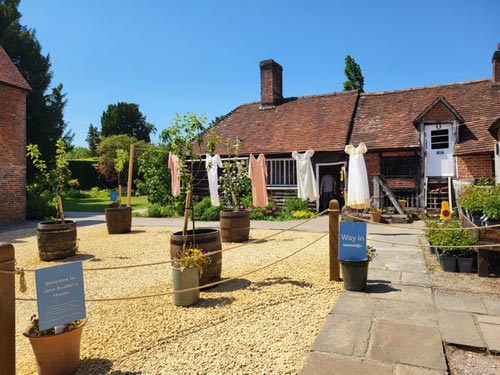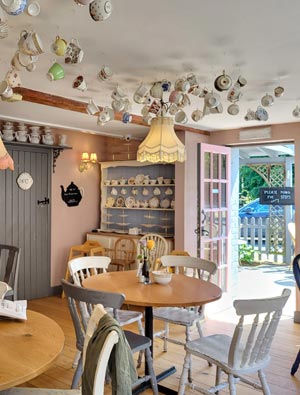Stepping into the pages of Pride and Prejudice

Giving a lived-in atmosphere: The courtyard, below centre and right; Jane Austen's writing table and bedroom
A simple board with ‘Jane Austen’s House’painted on it, stands beside a picturesque, red-brick cottage on a country road. A visit to Jane Austen’s House, in Chawton, Hampshire, United Kingdom, where she spent the last eight years of her life is an unforgettable experience.
It was in this cottage that the renowned author wrote and revised all six of her well -loved novels. In 1809, Jane and her sister Cassandra, with their mother and a friend, Martha Lloyd, moved to Chawton Cottage, offered to them by their brother Edward, after the death of their father. Edward had inherited estates in the area from rich relatives. Today, Jane Austen’s House is a museum, an important literary site, visited by many who are inspired by her memory.
As you enter the courtyard, a row of period gowns, gently fluttering in the breeze, give the cottage a lived-in atmosphere. Beyond the courtyard lies the garden, screened from the road. It is a beautiful, tranquil spot, with a lawn bordered by colourful flowers and shady trees. Some visitors were relaxing on mats laid out on the grass.
The entrance is through the kitchen, where some utensils are laid out on the table. A handwritten book of recipes lies open at a recipe for ‘white soup’, a favourite in Pride and Prejudice. Martha had kept this recipe book which gives an insight to the types of food the family partook of. An audio recording introduces Jane and her family and begins the story of her life in this house.

Cassandra’s Tea Room: Ending a perfect day with a cuppa
Going back to the courtyard, we entered the drawing room.The drawing room was the heart of the house, where the family gathered to entertain visitors, to do sewing and mending or to write their letters. Jane practiced the piano here each morning. Dinner being served early in the country, they had sat in the drawing room to relax and have tea. In the evenings, they had gathered around the fire to read aloud by candlelight or play games. It was in this room that Jane read ‘Pride and Prejudice’ aloud for the first time. She had received the first copies of her novel on January 27, 1813 and that evening she and her mother had read half of the first volume aloud to their neighbour, without revealing the identity of the author.
Sometimes when friends visited, they would push the furniture back and enjoy a session of informal dancing. The drawing room was furnished with comfortable chairs and sofas and, of course, Jane’s piano. A volunteer seated there told us that fragments of wallpaper dating back to the 1800s when the Austens were in residence, were discovered in this room in the late 1940s. This design known as ‘Chawton Vine’ was recreated and now covers the walls of the drawing room as it would have during Jane’s time there. A bureau cum bookcase, which belonged to Rev. Austen, Jane’s father, was also seen in the drawing room.
In the dining room, with the window facing the street, the table was laid for breakfast, adding another lived-in touch. Here too the wallpaper had the Chawton Vine design. By the window was a small 12-sided table, where interestingly, Jane had sat and written her stories.
Upstairs was Jane’s bedroom, which she shared with Cassandra. It is a modest room with built-in closets on either side. The window overlooks the courtyard and garden, making it a quiet, peaceful room away from the noise of the village road.
A larger room believed to have been Mrs. Austen’s now displays items of interest that belonged to the family. These include a collection of first editions of Jane’s works. Her first published novel, Sense and Sensibility, initially under the title Elinor and Marianne had been drafted in 1795, while living in Steventon, revised in Chawton in 1809-10 and published in 1811. It is interesting that all Jane’s novels were published anonymously during her lifetime. The title page of Sense and Sensibility stated that it was ‘By a Lady’. Following the popularity of Jane’s first two novels, her subsequent novels stated ‘By the Author of Sense and Sensibility and Pride and Prejudice’.

Going back in time: The entrance to Jane Austen's house
Mansfield Park was published in 1814 and Emma in December 1815. Even though Jane fell ill in 1816, she continued to write. She began Brothers in 1817, which was later published as Sanditon. Jane was only able to complete eleven chapters; the twelfth was half done. Sadly, she passed away on July 18, 1817, aged 41 years and was buried in Winchester Cathedral.
Northanger Abbey and Persuasion were published posthumously in December 1817 and for the first time, Jane Austen was identified as the author. In 1870, Jane’s nephew James Edward Austen-Leigh published ‘A Memoir of Jane Austen’which revived interest in her novels. Today, she is one of the most famous and beloved writers of English literature.
Jane being a prolific letter-writer, 16 of her surviving letters are preserved in the museum. They are very fragile and have been displayed with much care. Also on display is a signed extract from Winston Churchill’s Second World War Memoirs, in which he describes how Pride and Prejudice comforted him during a period of sickness in the middle of the war.
Among the other items on display is a patchwork coverlet done by Jane, Cassandra and their mother. Making use of small scraps of fabric they had created a striking, symmetrical design of diamonds.The museum also displays several other items showing Jane’s skill as a needlewoman as well as her personal belongings.
Going back in time, the house had been 300 years old when the Austens moved in. Over the years, it had been used as a farmhouse, a coaching inn and tenement housing. It had been purchased by the Knight family, become part of the Chawton Estate in 1769 and later inherited by Jane’s brother Edward. After Jane’s death, Cassandra and her mother continued to live there for the rest of their lives. For the next hundred years it had been used for various purposes and finally suffered from neglect.
In 1940, Dorothy Darnell, a resident of the area, set up the Jane Austen Society and aimed to buy the house and preserve it for the nation. Their efforts attracted the attention of Edward Carpenter, a lawyer from London, who purchased the house in 1948 and established the Jane Austen Memorial Trust to run it as a museum. It was opened to the public on July 23, 1949, by the Duke of Wellington. Since then, the Jane Austen House has been carefully restored and has flourished. It is protected by law and requires specialist care to conserve it.
Adjoining the souvenir shop, overlooking the road is the quaint Cassandra’s Tea Room with its specialty traditional cream tea with scones, clotted cream and jam. Eye-catching is its décor with the ceiling adorned with beautiful, mismatched tea cups. It was a refreshing conclusion to an interesting afternoon at the museum.
Searching for an ideal partner? Find your soul mate on Hitad.lk, Sri Lanka's favourite marriage proposals page. With Hitad.lk matrimonial advertisements you have access to thousands of ads from potential suitors who are looking for someone just like you.


